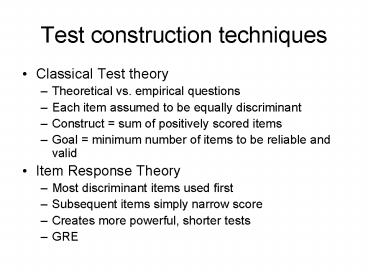Test construction techniques - PowerPoint PPT Presentation
1 / 16
Title:
Test construction techniques
Description:
Each item assumed to be equally discriminant. Construct = sum of positively scored items ... High scorers shy, uncomfortable with people, or prefer to be alone. ... – PowerPoint PPT presentation
Number of Views:76
Avg rating:3.0/5.0
Title: Test construction techniques
1
Test construction techniques
- Classical Test theory
- Theoretical vs. empirical questions
- Each item assumed to be equally discriminant
- Construct sum of positively scored items
- Goal minimum number of items to be reliable and
valid - Item Response Theory
- Most discriminant items used first
- Subsequent items simply narrow score
- Creates more powerful, shorter tests
- GRE
2
The MMPI (Hathaway and McKinley)
- Originally released in 1942
- Normed on a Minnesota hospital sample
- Quickly the most used/researched test for mental
illness - 1989 renorming, MMPI-2 (Butcher et al)
- Better normative group
- Updated items
- Slightly shorter (now 567 items)
3
Classical Test theory
- MMPI approach is empirical
- Sometimes (although not always) low face validity
- Forced answer format
- Criticisms
- Too long
- Needs 6th grade education to read
- Has tape administration format
- May be unfair to certain cultural groups
- Over identifies mental illness
4
Validity Scales
- Why would people lie?
- ?-Scale (omitted items) 10questionable,
30forget it - L-Scale (darn lies)
- F-Scale (Infrequency)
- Malingering
- People with mental illness do malinger
- Why?
- K-Scale (Defensive/self-deceptive)
- Can elevate in healthy people
- Correcting for K
5
Other validity scales
- These are not used as often
- Fb (F-back of test), looks at infrequency items
in latter half of test, to see if person stopped
paying attention. - Good F, bad Fb feel asleep
- VRIN Variable response indicator
- Compares similar questions
- Christmastreeing
- TRIN True Response Inconsistency
- Similar to above, another Christmastree scale
- Items should not be answered together unlike
VRIN, where they should be
6
Elevations
- 50 and below below normal (but thats OK)
- 50-65 generally normal range, getting toward 65
might be slightly worth noting - 65 abnormal
- By 80-90 symptoms considered severe
- Consult interpretation guide for specific
interpretations
7
Clinical Scales
- 1 Hypochondraisis
- Vague physical complaints, somatic symptoms
- High score neurotic focus on health
- Somatization disorder possible
- Real illness moderate elevation
- 2 Depression
- A generally good depression scale
8
Clinical Scales, Part 2
- 3 Hysteria
- Indicative of a tendency to break under stress
- May involve histrionic attention seeking
- Elevations more common in intelligent high-status
people and women in general - 4 Psychopathic Deviate
- More of an anger/rebelliousness scale
- Elevations in Black Americans
- Real high scores may be indicative of psychopathy
9
Clinical Scales Part 3
- 5 Masculinity/Femininity
- Measure conformity to gender role
- Actually does this reasonably well
- But otherwise a useless scale
- Does not identify homosexuality
- Does not predict domestic violence, etc
- 6 Paranoia
- Picks up both PPD and psychotic paranoia
10
Clinical Scales Part 4
- 7 Psychasthenia
- Anxiety, OCD, excessive worry, guilt
- Better indicator of trait anxiety, can pick up
some state anxiety - 8 Schizophrenia
- Picks up unconventional beliefs, perceptions,
social alienation, confusion, problems with
self-worth. - Often slightly higher in Black Americans, perhaps
due to feelings of societal alienation - Highly religious people
11
Clinical Scales Part 5
- 9 hypomania
- Impulsiveness, a need to act immediately (without
thinking) - Indicative of a tendency to solve problems
through action rather than thinking of long term
consequences. - Can be worrisome in combination with some other
scales - 10 Introversion
- High scorers shy, uncomfortable with people, or
prefer to be alone. Can be problematic with
other elevations
12
The Good the Bad and the Ugly
- Some scales highly predictive
- Elevations usually mean something is up
- Tests for lying
- Well known among clinicians
- Face validity irritation (somewhat a benefit)
- Too long
- Some scales misleading (Schizophrenia)
- Some scales useless (Gender conformity)
13
Profile Example 1
14
Profile Example 2
15
Profile Example 3
16
Next Week
- Scoring
- 2-Point Codes































